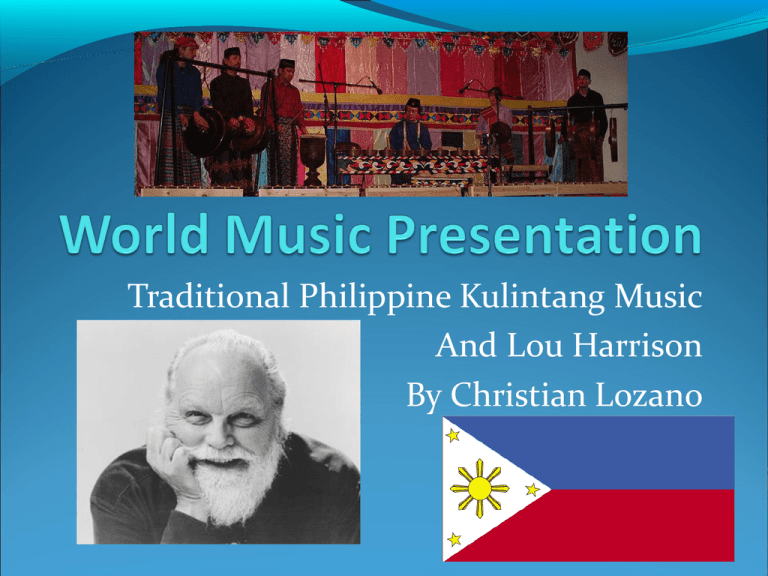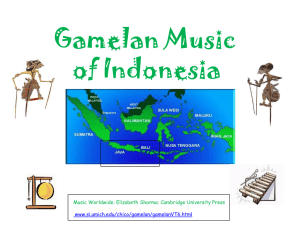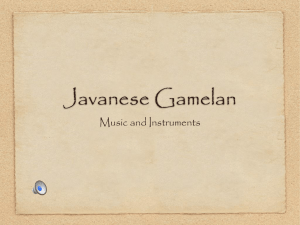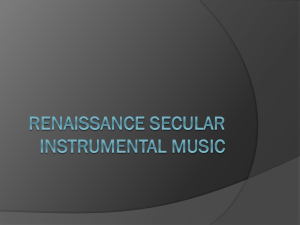Christian Lozano - The Spirit of Great Oak
advertisement

Traditional Philippine Kulintang Music And Lou Harrison By Christian Lozano Demographics of the Philippines Has a population of 97,976,603 (July 2009 est.) Land Mass of 298,170 sq. km. Ethnicities of the Philippines include: Tagalog 28.1%, Cebuano 13.1%, Ilocano 9%, Bisaya/Binisaya 7.6%, Hiligaynon Ilonggo 7.5%, Bikol 6%, Waray 3.4%, other 25.3% The two official languages are Filipino (based on Tagalog) and English. There are also eight other dialects. The two main religions are Roman Catholic 80.9% and Islamic 5% . With an Other 14.1%. The Philippines The Philippines archipelago is made up of 7,107 islands. The islands are categorized into three main geographical divisions: Luzon, Visayas, and Mindanao. The capital is Manila. Became a Spanish colony in the 16th Century. Was ceded to the US in 1898 after the Spanish American War. Independence on July 4th 1946. Kulintang of the Southern Philippines Kulintang is a modern term for an ancient instrumental form of music composed on a row of small, horizontally-laid gongs that function melodically, accompanied by larger, suspended gongs and drums. Based on the traditions of the Maranao and Maguindanao people. Evolved from a simple native signaling tradition. A kulintang is a set of metal gong kettles which are laid horizontally upon a rack. It is played by striking the bosses of the gong with two wooden beaters. Kulintang ensembles usually consist of five to six instruments. One of the three major gong ensembles alongside the Gamelan in Indonesia and the Piphat in Thailand. Tuning is based off the Pelog and Slendro scales of Java because their was great variation between each set of instruments due the differences in make size and shape. The Scales and Rhythmic Mode Pelog Slendro Pelog has seven notes, but Slendro is a pentatonic scale that many gamelan ensembles only have keys for five of the pitches. Even in ensembles that have all seven notes, many pieces only use a subset of five notes. divides an octave into 5 fairly equal parts. Rhythmic Mode is defined as a musical unit that binds together the entire five instrument ensemble. By adding together the various rhythms of each instrument, one could create music and by changing one of the rhythms, one could create different music. This is the basis of the rhythmic mode. Kulintang Music Like the other two, Kulintang music is primarily orchestral with several rhythmic parts orderly stacked one upon another. However, Kulintang music differs in many aspects from gamelan music, primarily in the way the latter constructs melodies within a framework of skeletal tones and prescribed time interval of entry for each instruments. The framework of Kulintang music is more flexible and time intervals are nonexistent, allowing for such things as improvisations to be more prevalent. The main purpose for Kulintang music in the community is to function as social entertainment at a nonprofessional, folk level. The Kulintang player functions not only as the one carrying the melody, but also as the conductor of the entire ensemble. He controls the tempo of the song. The Instruments Dabakan Kulintang Agung http://www.youtube.com/watch?v=2Daujjju iL4 Babendil Gandingan Lou Harrison Born on May 14, 1917 and died on February 2, 2003. Was an American Composer Born in Portland, Oregon. Graduated Burlingame High School in Burlingame, California. Then moved to San Francisco. There he was exposed to different types of music such as Cantonese opera, Native American, Spanish, jazz, and Indonesian music which greatly influenced him. Harrison took Henry Cowell's "Music of the Peoples of the World" course, and also studied counterpoint and composition with him. Later went to UCLA and took lessons from Arnold Schoenberg which led to an interest in Schoenberg's twelve-tone technique. Most of his pieces were percussive works using unconventional materials. 1943, moved to New York to work as a music critic for the Herald Tribune where he met Charles Ives. Harrison conducted the premiere of Ives Symphony No.3. Ives wins the Pulitzer Prize for Music for the piece and gave half the money to Harrison. He began to follow composer Collin McPhee who did research on Indonesian Music. Harrison is particularly noted for incorporating elements of the music of nonWestern cultures into his work, with a number of pieces written for Javanese style Gamelan instruments. Concerto in Slendro Composed in 1961. Score was written for a violin, two tack pianos, a celesta, and percussion. Influenced by Gamalan instruments, he created percussion instruments made out of tin cans and metal wash tubs to resemble them. Other compositions do use a few Gamalan instruments. Imitates the use of the slendro scale in Kulintang and Gamalan music. http://www.youtube.com/watch?v=nwfBKvFW968 The Comparison Similarities Differences Concerto in Slendro tries to Time signature in the imitate the slendro scale. The instruments are created to imitate the Kulintang/Gamalan gongs. Same number of instruments are used to resemble a Kulintang ensemble. Relatively they are at a moderate tempo. The Kulintang is used to carry the melody like the Violin does in Concerto. Instruments are created with the materials available to them. Kulintang is non-existent so it is mostly improvised. Not actual Kulintang instruments are used in Concerto. Kulintang is used as the lead instrument while the Violin leads in Concerto. Works Cited http://en.wikipedia.org/wiki/Philippines http://en.wikipedia.org/wiki/Kulintang http://en.wikipedia.org/wiki/Lou_Harrison http://www.classical.net/music/recs/reviews/n/nwr80643a.php http://gmvfeel.egloos.com/932901 http://www.ucsc.edu/oncampus/currents/97-04-21/harrison.photo.htm https://www.cia.gov/library/publications/the-world-factbook/geos/rp.html http://en.wikipedia.org/wiki/Manila http://en.wikipedia.org/wiki/Celesta http://www.youtube.com/watch?v=2DaujjjuiL4 http://4.bp.blogspot.com/_5DWyU5zqZY/SiW6FfuHhtI/AAAAAAAAARs/vLbdfnlD7LY/s400/Chocolate_hills_bohol_P hilippines.jpg











